I live in the suburbs. I know there are art-lovers here, but we are fairly uncommon--compared to those who live in hipper inner city neighborhoods. We are less concentrated in the population for the simple reason that the suburbs themselves are less concentrated. The suburbs place a high premium on outward conformity, so it's hard to tell who's artsy. Deeper inside the city, people are more likely to wear their artsiness outwardly--in their lawn art, their art cars, their fashions, their tattoos and hairstyles. But we suburbanites keep that stuff inside the walls of our homes. There are exceptions--the suburbs are too vast to be homogenous. But the problem with the suburbs is that there isn't enough of a concentration of artistic types to encourage arts institutions to form. Few people start galleries in the 'burbs. We hardly have any arts institutions.
But even so, there are exceptions. The Pearl Fincher Museum of Fine Art is one I've written about before. Located in Spring, it is near Steubner-Airline just north of FM 1960 on Cypresswood Dr. It's in a neighborhood that appears to be fairly upper-middle-class. The houses are the brick generica favored by Houston developers. Just to give you an idea of how spread out things are up there, the Woodlands is about 14 miles from the Pearl Fincher. Nonetheless, the Pearl Fincher has community support--that can be seen by their well-attended openings, and their website claims that they have over 2000 donors. (They are not a 501(c)3 organization, so their finances are not reported publicly. Correction: They are a 501(c)3, but the name of the non-profit is the Cypress Creek Fine Art Association, not the Pearl Fincher Museum of Fine Art.)
Most of their previous exhibits have been exhibits by local artists (including student shows) or exhibits culled from the collections of local collectors. This seems like a good exhibition strategy for a young (established in 2008) suburban museum. It's an approach that promotes buy-in from the local artistic community. (Indeed, the Pearl Fincher has had a series of shows with the subtitle "Northwest Houston Collects".) But it's not a viable long-term strategy, because once you have that buy-in, you need to occasionally show things that are not from your own backyard. You're nurturing a local scene, and that means paying attention to that local scene, which the Pearl Fincher is doing well, but it also means injecting new ideas into that scene.
So I was excited when I heard about Luxuriant Refuse, a contemporary group show curated by Melissa Grobmyer and featuring the work of Adela Andea, Johnston Foster, Alison Foshee, Sarah Frost, Gwyneth Leech, Shawne Major, Aurora Robson, Betsabeé Romero, and Paul Villinski.
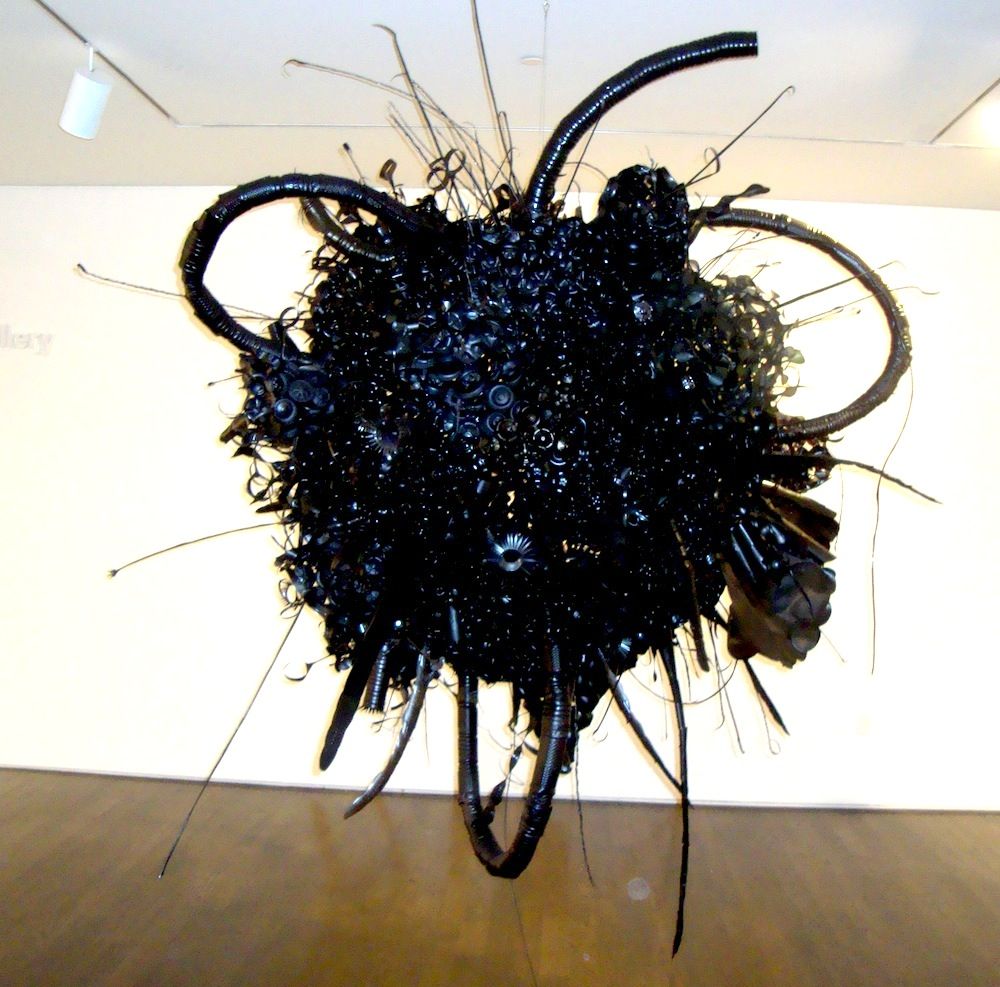
Aurora Robson, Belch (aka Tarball), 2009, discarded PET bottles, tinted polycrylic, rivets, steel armature, mica powder
Aurora Robson's work may be familiar to Houstonians from The Great Indoors, her installation at the Rice Gallery, or her installation at the Rice Recreation and Wellness Center. Those colorful pieces contrast to this large black encrusted sphere, floating slightly above eye-level like a menacing alien spacecraft.
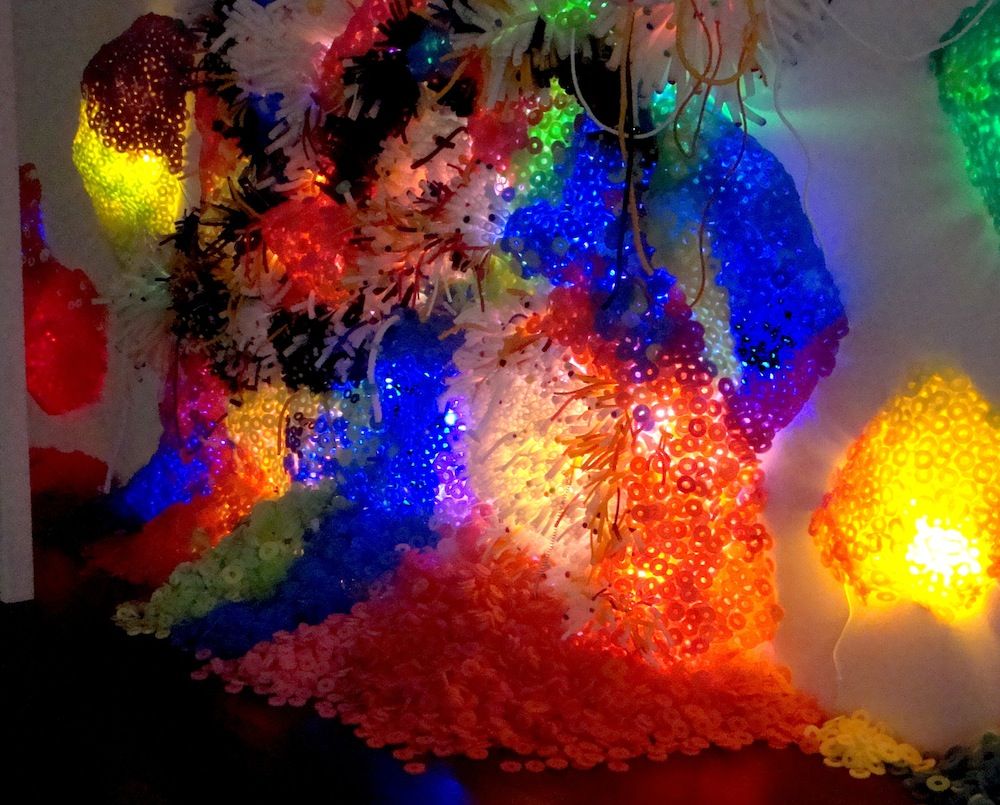
Adela Andea, Bioluminescence, 2012, pool noodles and cold cathode fluorescent lights mounted on wire mesh
Equally alien, but much more colorful is Bioluminescence by Adela Andea. I question the categorization of pool noodles as refuse--is she actually making sculpture out of thrown-away materials, or did she buy a bunch of pool noodles new? But who cares? It's a pretty work and it's something I haven't really seen before at the Pearl Fincher--a site specific installation. (I know Andea has presented this work elsewhere, but I suspect it varies depending on the place of installation.)
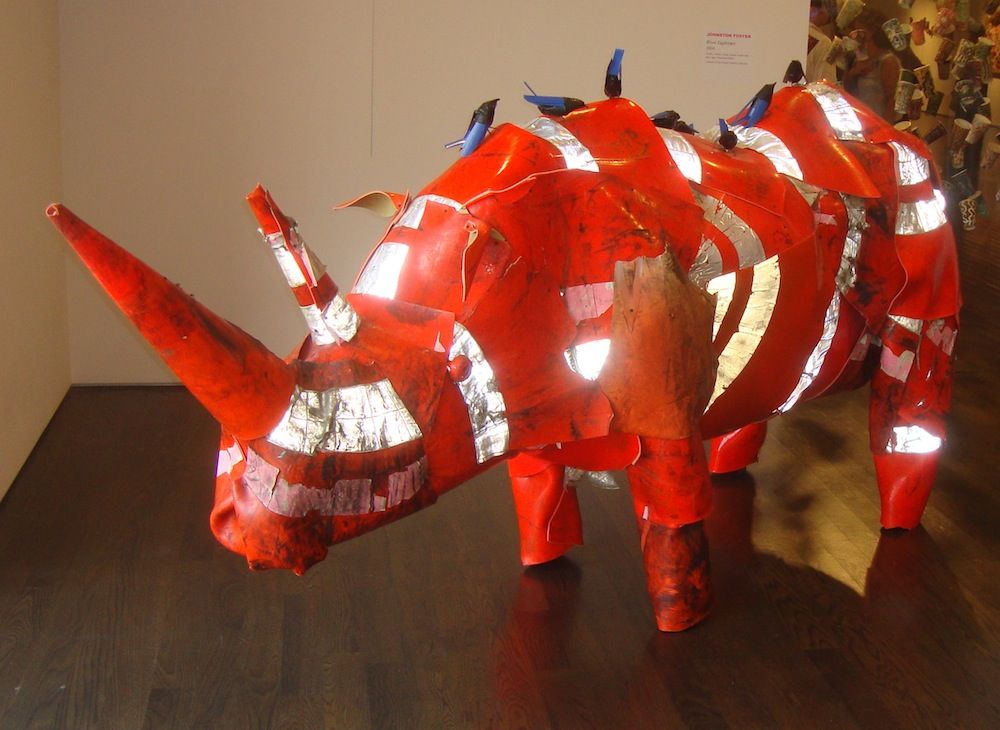
Johnston Foster, River Euphrates, 2004, traffic cones, wood, plastic trash cans, duct tape, Venetian blinds
Johnston Foster's work--animals assembled from castaway plastic detritus--fits the theme of the show better. River Euphrates, a rhino made out of traffic cones, was a crowd-pleaser. The inclusion of the oxpeckers on the rhino's back was a nice touch.
The thing with pieces like River Euphrates, Bioluminescence and Belch (aka Tarball) is that they look cool. One could imagine someone curating a show of art made of trash and debris that would have been much more austere, more intellectual, more challenging. The choice here was to be accessible. Is the audience being condescended to? Is there a calculation that this suburban audience might not appreciate more difficult work? Or to put it another way, is there a deliberate choice not to alienate the audience?
(Years ago, when I worked for The Comics Journal, we were about to run an interview with cartoonist Paul Chadwick, the creator of a comic called Concrete. I mentioned to one of the editors that to me, Chadwick seemed totally mainstream and therefore should not be included in our magazine. This editor wisely responded, "To you and me he may seem mainstream, but there are many readers for whom Chadwick is quite radical." This has stuck with me and seems appropos here.)
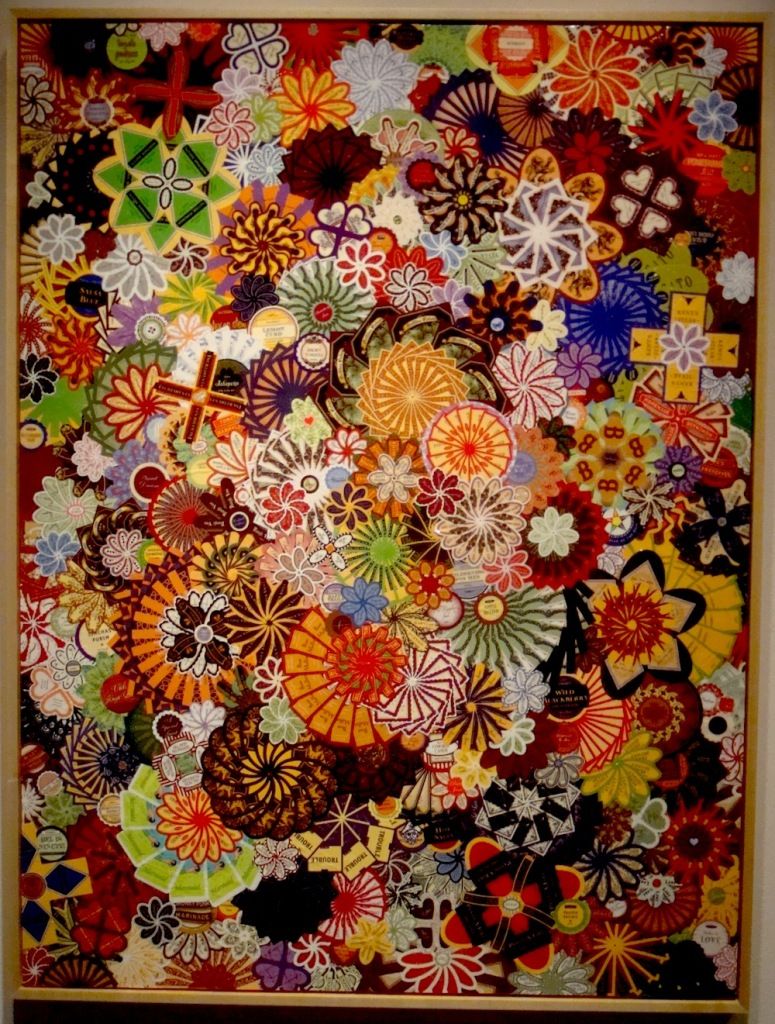
Alison Foshee, Ivanhoe, 2012, labels on canvas
The artists in this show veer between those who create work that is pretty and those whose work makes you think, "Wow, that's amazing." (Or sometimes both.) Alison Foshee uses product labels to create her beautiful, somewhat abstract flowers.
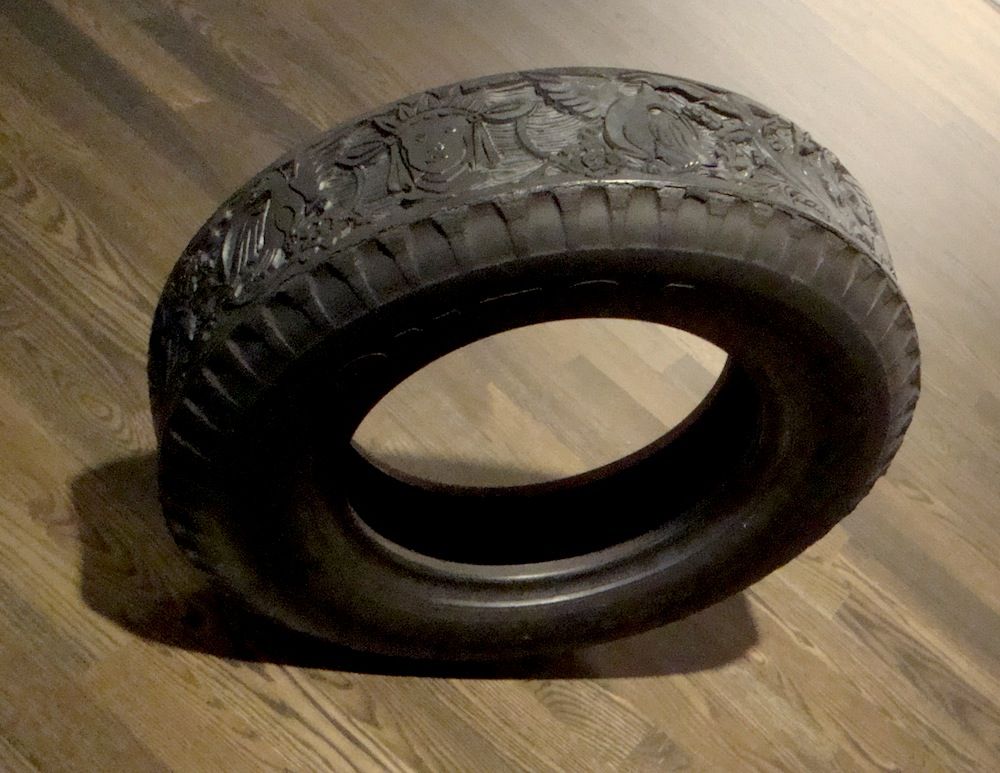
Betsabeé Romero, 2007, Tire, carved rubber truck tire
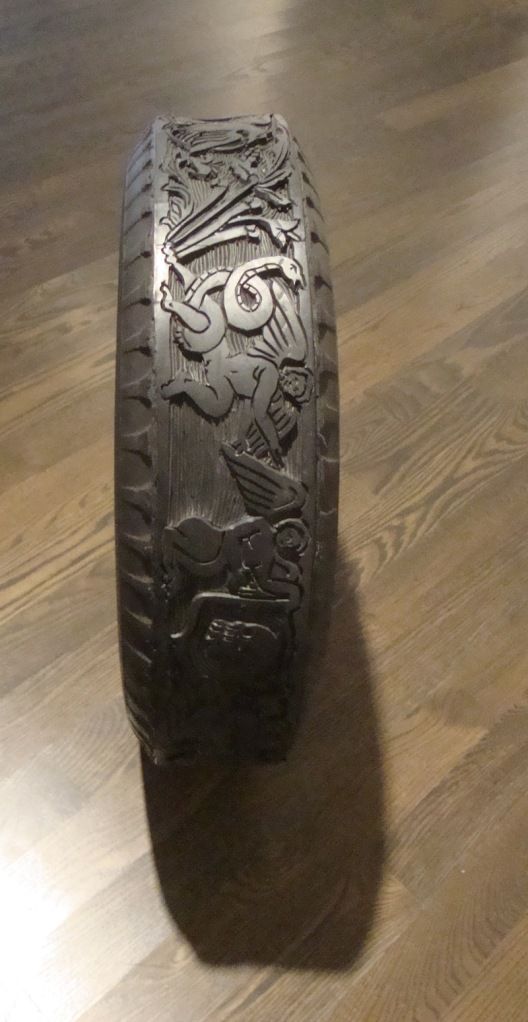
Betsabeé Romero, 2007, Tire, carved rubber truck tire
Betsabeé Romero's Tire belongs more in the "wow" category. Houstonians may remember his work which was included in the show Cosmopolitan Routes: Houston Collects Latin American Art at the MFAH.
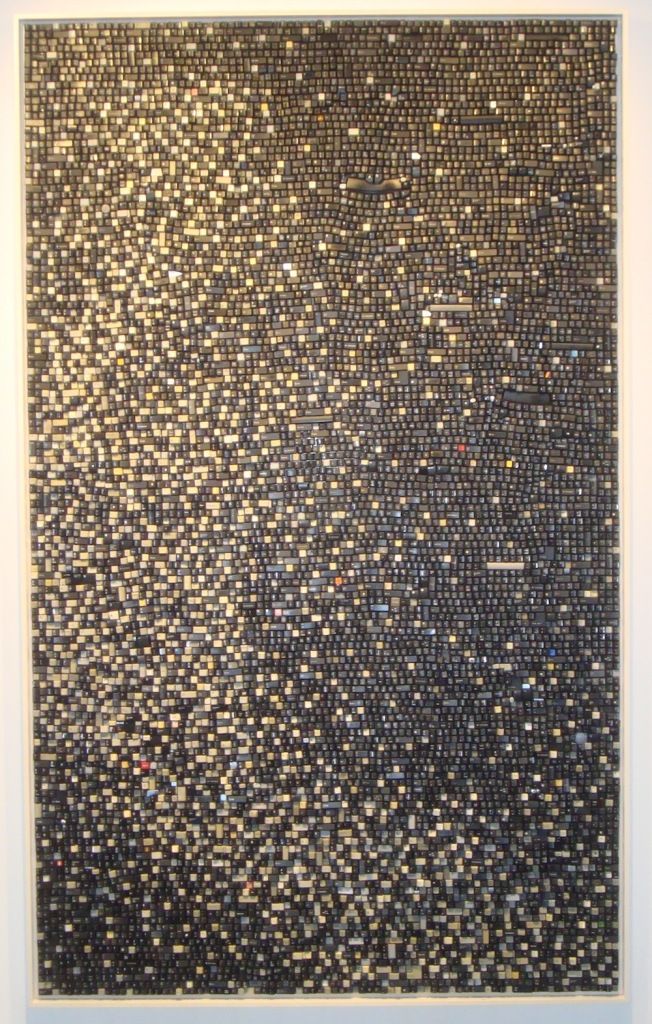
Sarah Frost, Sign Off, 2011, discarded computer keyboard keys
Sarah Frost is also one of the "wow" artists. Sign-Off, like many of her pieces, is composed of old computer keyboard keys. These keys are not only trash (and therefore appropriate for inclusion in this exhibit), but they're obsolete as well. Sign-Off is a formal work of light and dark, but it is also a reminder of how we produce millions of these little things knowing that most will be thrown away after at most a few years.
Frost was one of the stand-out artists at the Houston Fine Art Fair last year, and her piece there was one of the ones that sold. (I will return to the subject of the HFAF below.)
Paul Villinski, Consonance, 1993-2006, gold leaf on found work gloves
Paul Villinski's Consonance is one work that is neither "pretty" nor "wow," and to me is perhaps the most intriguing work in the show. It combines the grungy (old work gloves) with the glamorous (gold leaf). The seven gloves are arranged horizontally so that the boundary between glove and gold leaf forms a kind of horizon line. He has, in a sense, created a landscape. This piece is from a series he did with gloves where he combined the sweaty, dirty work glove with some elegant addition, like gold leaf or embroidery.
I mentioned the Houston Fine Art Fair earlier. They sponsored this exhibit and had promotional material available for attendees on opening night. In addition, curator Melissa Grobmyer is a partner with M.K.G. Art Management, LLC., a private company that provides art acquisition and divestment services, appraisals, art inventory management, art leases and corporate archival services. Now it's not unusual for a museum show to be sponsored by a private company. It's the cost we have to pay to see exhibits in a country where the government doesn't typically pay the bills for art museums. But Luxuriant Refuse is a little different--both Hamptons Expo Group (parent company of HFAF) and M.K.G. are companies in the art business. And doing a show like this is a way to drum up business for themselves.
In fact, I think it's kind of brilliant (if ethically shaky). We know there are a lot of well-off people in North Houston. Some of them are into art, and the Pearl Fincher Museum has been cultivating those art-lovers for the past four years. M.K.G. would no doubt like to serve as art consultant for energy company executives in the Woodlands. HFAF would like the collectors who loan work to the Pearl Fincher--as well as aspirational collectors--to visit the art fair this September. I have no idea what deal was made between Hamptons Expo Group and the Pearl Fincher or between M.K.G. and the Pearl Fincher. But on the face of it, each party benefits. M.K.G. and HFAF get access to potential clients while the Pearl Fincher gets a very nice art exhibit. However, the exhibit is also risky for the Pearl Fincher--it's possible that people will see the museum as a shill for the two commercial enterprises. (Tyler Green would have a meltdown over this.)
I'm not sure how I feel. The blatant combination of art business and art museum feels a little skeevy. But I suspect that without the help of M.K.G. and Hamptons Expo Group, the Pearl Fincher would have found it difficult to mount a show like Luxurient Refuse. And that would have been a shame. It's the kind of show that can ease skeptical people into contemporary art. And I think this is an important task for museums--particularly those like the Pearl Fincher Museum located in the vast suburban plain far from the art center.




Robert,
ReplyDeleteI really enjoyed your post. Thanks for coming out to the Pearl again. You obviously spent a lot of time with the artwork and I appreciate your thoughtful evaluation.
I wanted to clarify one point. The Pearl Fincher Museum of Fine Arts is a 501(c)(3) organization, though you would not be able to find it under that name. Cypress Creek Fine Art Association was the original organization that raised funds for the building renovation before the Fincher family gave the funds and their mother's name to the facility. Our 501(c)(3) is still registered under that original name and there is a official dba filed with Harris County as Pearl Fincher Museum of Fine Arts. As I look back, this is something that is definitely not clear on our website.
Thanks again for your visit,
Rosemary Hickman
Education Director
Pearl Fincher Museum of Fine Arts
No wonder I couldn't find you guys in GuideStar. Thanks for the clarification.
ReplyDeleteDear Robert:
ReplyDeleteThank you for your review. I want to address a couple of points you made in your assessment of Luxuriant Refuse.
My whole career, I have resisted the idea that art has to be austere, opaque, or challenging (whatever that means) to engage the viewer in a serious thought process or to qualify as “good” art. If something is beautiful or “cool,” as you say, should that somehow disqualify the work as “good” and automatically become prosaic or pandering? Can’t a work of art that is “cool” also invite the viewer to think more deeply about the nuance of a subject matter?
Furthermore, as Abstract Expressionism, Minimalism, Conceptualism, and Pop came to the foreground in the American art establishment in the mid 20th century, a decided sea-change in artist training and development encouraged “idea” and discouraged draftsmanship, or “craft”.
The result is a contemporary art culture that undervalues skill and overvalues “concept.” Add in an exploded art market and lack of traditional idea of connoisseurship, and guess what results: a lot of very high concept art whose opacity is its only virtue, and which is actually as deep as a puddle. Talk about a shill.
In my opinion, art should engage us on many levels. Beauty can be a virtue, as can “wow” factor. I have been thinking about the theme of the show for years now, and actually chose art that was decidedly not didactic or pedagogical, because I don’t like being preached to. I touch on this in the exhibition brochure. The placement of the show in the suburbs had everything to do with finding an art space to mount the show in and nothing to do with somehow bringing suburbanites into a dialog about contemporary art. If that has happened, fantastic! But that was not the point.
Finally regarding your concerns about the ethics of mixing the art business, the museum business, and corporate money: I am sure you know that museums are supported by corporate and private money without which they would not exist. Museums have large development departments that specialize in raising money for the institution.
In exchange for their generosity, the corporation or private individual then gets to have their name on the building, exhibition brochure, or party invitation. They get to publicly communicate that they are embedded in the cultural landscape of a place. This buying and selling of influence is very much a part of the art world in the US, as you know. Ethics come in when the benefactor gains too much influence with the institution, unbalancing decision-making etc. This is admittedly a fine line that I will not argue here.
Furthermore, art dealers regularly donate or heavily discount works of art by artists they are promoting, in order to get the work into the museum and in order to increase the salability of the artist’s work. This symbiosis is firmly in place, ethically suspect or not.
But specifically, what is “skeevy” about HFAF supporting an exhibition at the Pearl Fincher? I am not sure how it is any different from any other corporate support of any other exhibition at any other institution. Of course HFAF wants people in the Woodlands to know about the art fair. To pretend that corporations give money to cultural institutions out of the pure generosity of their corporate hearts is silly. But I am not sure what is unethical about this particular arrangement.
Finally, just to clarify my involvement, I proposed the exhibition to the Pearl Fincher months before my firm took on HFAF as a client. If my company garners a client out of the show, great, but that was not the point of mounting the show. It was just an idea I wanted to explore, having been thinking and writing about art in various capacities for 20 years. It worked out that the timing was perfect. We needed money to mount the show, and HFAF, as well as Crateworks and ANR, stepped up.
I am glad you enjoyed the show. It was fun to put together, and I hope to have the opportunity to do it again in the future.
Melissa Grobmyer